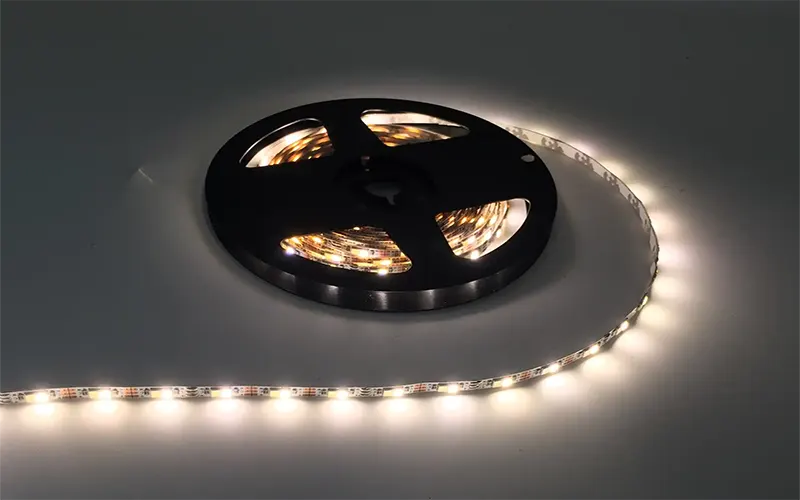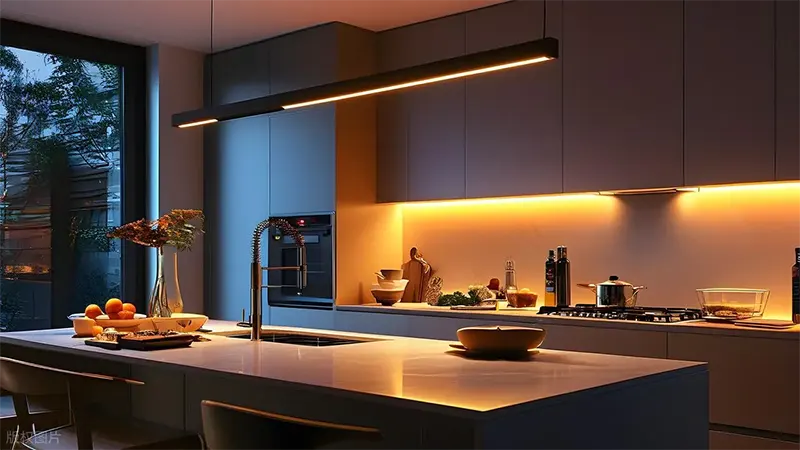The Tunable White LED Strips is a classic LED light strip. Unlike traditional single-colour-temperature strips, it allows users to adjust the light according to their environment and mood, seamlessly switching between crisp, cool white light (such as 6500K) and warm white light (such as 2700K).
This dual-color LED strip’s flexible color temperature control not only enhances the ambiance of a space but also improves visual comfort and energy efficiency. This article will detail the working principle, advantages, purchasing considerations, and differences between the Tunable White LED Strips and other light strips to help you determine if it’s right for your project.
What is a Tunable White LED Strips?
Tunable White LED Strips are a type of light strip product that allows for adjustable color temperature. It typically consists of two LED chips with different color temperatures—one emitting warm white light (approximately 2700K) and the other emitting cool white light (approximately 6500K). More details, pls read How to Choose the Perfect Flexible LED Strip Lights?
By controlling the brightness ratio of the two sets of LEDs, a smooth transition from warm white to cool white can be achieved. Custom color temperatures are also supported; some combinations offer 3000K and 6500K.

Common tunable white LED strips light specifications:
- Voltage selection: DC12V or DC24V, but DC24V is more common.
- Power range: 10W–20W/meter, custom power supported.
- Color temperature range: 2700K–6500K
- Dimening methods: PWM dimming, 0-10V, DMX or wireless control.
How do Adjustable White LED Light Strips Work?
The key to tunable white LED light strips lies in their dual-color-temperature chip technology and intelligent control. This involves two chips with different color temperatures and different control mechanisms.
Chip Composition:
Unlike single-color white LED strips, CCT LED strips typically consist of alternating arrangements of two LED chips with different color temperatures:
- WW Chip: Warm White LED chip, like as the 2700K.
- CW Chip: Cool White LED chip, like as the 6500K.
Control Mechanism:
The LED strip controller controls the brightness ratio of the CW and WW chips separately via independent channels (PWM dimming):
- Warm White Light: 100% driving the WW chip, 0% driving the CW chip.
- Cool White Light: 0% driving the WW chip, 100% driving the CW chip.
- Neutral White Light: 50% driving the WW chip, 50% driving the CW chip.
- Any Color Temperature: Achieve a smooth color temperature transition by precisely adjusting the ratio between the two.
Which Lighting Projects Require Adjustable White LED Strips?
Unlike traditional LED strips that only output a fixed color temperature, adjustable white LED strips (CCT Tunable LED Strip) can freely switch between warm white and cool white light, making lighting design more flexible, intelligent, and closer to human circadian rhythms.

Multi-functional Space Design
Adjustable white LED strips can switch color temperatures according to different functional needs, eliminating the need for multiple light fixtures. One strip can meet three different lighting requirements, reducing hardware costs and improving ease of use.
- Nighttime: 5000K–6500K Cool White Light
Suitable for kitchens and work areas, simulating natural sunlight to enhance focus and alertness, and improve work efficiency. - Daytime: 3500K–4500K Neutral White Light
Used in living rooms, meeting rooms, and other spaces, providing a bright yet comfortable atmosphere with more realistic visual effects. - Nighttime: 2700K–3000K Warm White Light
Suitable for bedrooms, dining rooms, and rest areas, creating a soft, relaxing light environment to soothe emotions and promote sleep.
Enhanced Visual Comfort
Adjustable white LED strips simulate changes in ambient light throughout the day, dynamically balancing the indoor lighting environment. Whether for work or rest, it avoids visual fatigue caused by a single cool white light. The color temperature adjusts according to changes in outdoor sunlight, making indoor lighting feel more natural.
Energy Saving and Intelligent Control
Adjustable white LED strips can be integrated with intelligent systems to achieve automated energy-saving strategies. They can automatically dim, sensing natural light intensity and automatically reducing output to minimize energy consumption.
Furthermore, in most applications, lower brightness warm light is sufficient to meet environmental needs, thus reducing electricity waste.
Suitable for Commercial and Artistic Lighting
The flexible color temperature switching of adjustable white LED light strips allows commercial spaces to easily create diverse atmospheres. For example, in restaurants and hotels, we can suggest using bright, neutral light during lunchtime to create a clean environment; and switching to warmer light during dinnertime to make guests more relaxed and extend their stay.
Five Key Considerations Before Buying a Tunable White LED Strips
While there aren’t as many dual-color LED strips as single-color ones, there are still quite a few. They come in different wattages and numbers of LEDs. Therefore, you need to choose the right one based on your needs.
Color Temperature Range
Color temperature is crucial as it affects mood. Therefore, confirm that the color temperature range offered by the light strip meets your needs. A common range is 2700K-6500K, covering most everyday applications from warm yellow to cool white.
Color Rendering Index (CRI)
This is an indicator of a light source’s ability to reproduce the true colors of objects. For high-quality lighting, a CRI ≥ 90 is strongly recommended.
The higher the CRI, the more vibrant and realistic the colors will appear on illuminated objects (such as food, paintings, and furniture). Our dual-color LED strips all have a CRI of 90 or higher.
Control Method:
Dual-color LED strips require a controller. Consider how you want to control the strip. Do you want a simple remote control, a mobile app, or even integration into a whole-house smart home system? This will determine the type of controller you need.
Waterproof Rating:
- IP20: Not waterproof, suitable for dry indoor environments such as cabinets and ceilings.
- IP65: Dustproof and water-resistant, suitable for humid environments such as kitchens and bathrooms.
- IP67/IP68: Primarily for outdoor use or direct water contact. However, immersion in water is not recommended.
Power and Brightness
The power (watts/meter) of the LED strip directly determines its brightness. You need to plan the power consumption carefully to ensure a suitable LED power supply. Choose the appropriate power based on the lighting requirements of the installation location (ambient lighting or main lighting), and equip the power supply with sufficient power margin (20% increase recommended).
How to Control Adjustable White LED Light Strips?
For small-area adjustable white LED light strips, a controller is generally used. With the increasing demands of younger users for convenience, the mainstream control methods are as follows:

- Standard Control: Use an infrared remote control or wireless wall controller to directly select a preset color temperature mode or perform stepless adjustment.
- Smart Control: Connect to a mobile app via Wi-Fi or Bluetooth. You can achieve: remote control, timed on/off switching, and even set automated color temperature schedules to simulate sunrise and sunset.
- Whole-Home Smart Integration: Connect the light strip to smart home platforms such as Apple HomeKit and Google Home via a gateway using protocols like Zigbee, enabling联动 (interconnection/linkage) with other devices (such as sensors and curtains) and voice control.
Tuanable White LED Strips Compared to Other LED Strips
To help you make the most suitable choice, we’ll provide a clear comparison. We’ll primarily compare adjustable white LED strips with monochrome and RGB LED strips.
| Features | Adjustable white LED strip | Single LED strip | RGB LED strip |
| Functions | Adjusting warm white and white light color temperatures | Single fixed color temperature | Three color temperatures, then produce colored light. |
| White light quality | Very high (adjustable and usually high CRI) | Depends on the model purchased | Poor (mixed RGB, bluish and impure) |
| Suitable Scenarios | Spaces that prioritize white light quality and ambiance | Spaces requiring only basic lighting | Entertainment and decorative spaces that need a colored ambiance |
| Cost | Medium | Lowest | Medium (Smart version is more expensive) |
| Selection Recommendations | Ideal for most home and commercial environments. | Suitable for those with limited budgets and simple functional requirements. | For those who need colored light to create dynamic effects. |
Conclusion
Tunable white LED light strips are an indispensable innovative product in modern lighting design, offering adjustable color temperatures. They are also adaptable to various scenarios, perfectly suited for both residential and commercial spaces.
If you are looking for a lighting solution that balances functionality and aesthetics, adjustable white LED light strips are the ideal choice. Please browse our carefully selected series of adjustable white LED light strips with high color rendering index (CRI≥90) and wide color temperature range, as well as matching smart controllers.
FAQs
No. Adjustable white light strips achieve color temperature adjustment by mixing warm white and cool white light. You can adjust the warm white first, then the cool white, or adjust both simultaneously to produce white light. Therefore, the entire light strip can only display one mixed color temperature at a time.
No, adjustable white LED strips can only produce white light ranging from warm yellow to cool white. If you need colored light, you should choose RGB or RGBW LED strips, or consider RGBCCT (full-color + adjustable white) LED strips.
There are many reasons for this, including incorrect color temperature and color. However, a more likely cause is voltage drop. A voltage decrease (due to excessively long circuits) can lead to inconsistent colors at the beginning and end of an LED strip.
Yes. Modern adjustable white light strips support WiFi, Bluetooth, or Zigbee control systems, allowing you to adjust color temperature and brightness using apps like Tuya, Smart Life, or Philips Hue.
Yes, but you must confirm the voltage and wattage. Additionally, you’ll need a dual-color temperature LED light box set; otherwise, color temperature adjustment is not possible.
